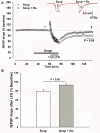Slice orientation and muscarinic acetylcholine receptor activation determine the involvement of N-methyl D-aspartate receptor subunit GluN2B in hippocampal area CA1 long-term depression
- PMID: 22082088
- PMCID: PMC3226435
- DOI: 10.1186/1756-6606-4-41
Slice orientation and muscarinic acetylcholine receptor activation determine the involvement of N-methyl D-aspartate receptor subunit GluN2B in hippocampal area CA1 long-term depression
Abstract
Background: The contribution of different GluN2 subunits of the N-methyl D-aspartate (NMDA) receptor to the induction of bidirectional hippocampal synaptic plasticity is a controversial topic. As both supporting and refuting evidence for the hypothesis of subunit specialization in opposing directions of plasticity has accumulated since it was first proposed a few years ago, we hypothesize that differences in experimental conditions may have in part contributed to some of the inconsistent results from these studies. Here we investigate the controversial hypothesis that long-term depression (LTD) is preferentially induced by GluN2B-containing NMDA receptors in area CA1 of hippocampal slices.
Results: We find that brain slices from 2-3 week old rats prepared in the sagittal orientation have GluN2B-independent LTD whereas slices prepared in the coronal orientation have GluN2B-dependent LTD. There was no difference between the orientations in the fraction of the NMDAR EPSC sensitive to a GluN2B-selective antagonist, leading us to believe that the intracellular signaling properties of the NMDARs were different in the two preparations. Coronal slices had greater association of LTD-related intracellular signaling protein RasGRF1 with GluN2B relative to sagittal slices. Antagonism of muscarinic acetylcholine receptors (mAChRs) in the sagittal slices returned LTD to a GluN2B-dependent form and increased the association of GluN2B with RasGRF1.
Conclusions: These results suggest a novel form of NMDAR modulation by mAChRs and clarify some disagreement in the literature.
Figures




References
Publication types
MeSH terms
Substances
Grants and funding
LinkOut - more resources
Full Text Sources
Research Materials
Miscellaneous

